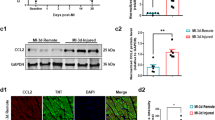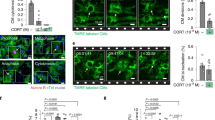Abstract
Granulocyte colony-stimulating factor (G-CSF) was reported to induce myocardial regeneration by promoting mobilization of bone marrow stem cells to the injured heart after myocardial infarction, but the precise mechanisms of the beneficial effects of G-CSF are not fully understood. Here we show that G-CSF acts directly on cardiomyocytes and promotes their survival after myocardial infarction. G-CSF receptor was expressed on cardiomyocytes and G-CSF activated the Jak/Stat pathway in cardiomyocytes. The G-CSF treatment did not affect initial infarct size at 3 d but improved cardiac function as early as 1 week after myocardial infarction. Moreover, the beneficial effects of G-CSF on cardiac function were reduced by delayed start of the treatment. G-CSF induced antiapoptotic proteins and inhibited apoptotic death of cardiomyocytes in the infarcted hearts. G-CSF also reduced apoptosis of endothelial cells and increased vascularization in the infarcted hearts, further protecting against ischemic injury. All these effects of G-CSF on infarcted hearts were abolished by overexpression of a dominant-negative mutant Stat3 protein in cardiomyocytes. These results suggest that G-CSF promotes survival of cardiac myocytes and prevents left ventricular remodeling after myocardial infarction through the functional communication between cardiomyocytes and noncardiomyocytes.
This is a preview of subscription content, access via your institution
Access options
Subscribe to this journal
Receive 12 print issues and online access
$209.00 per year
only $17.42 per issue
Buy this article
- Purchase on Springer Link
- Instant access to full article PDF
Prices may be subject to local taxes which are calculated during checkout





Similar content being viewed by others
References
Orlic, D. et al. Mobilized bone marrow cells repair the infarcted heart, improving function and survival. Proc. Natl. Acad. Sci. USA 98, 10344–10349 (2001).
Ohtsuka, M. et al. Cytokine therapy prevents left ventricular remodeling and dysfunction after myocardial infarction through neovascularization. FASEB J. 18, 851–853 (2004).
Moon, C. et al. Erythropoietin reduces myocardial infarction and left ventricular functional decline after coronary artery ligation in rats. Proc. Natl. Acad. Sci. USA 100, 11612–11617 (2003).
Parsa, C.J. et al. A novel protective effect of erythropoietin in the infarcted heart. J. Clin. Invest. 112, 999–1007 (2003).
Zou, Y. et al. Leukemia inhibitory factor enhances survival of cardiomyocytes and induces regeneration of myocardium after myocardial infarction. Circulation 108, 748–753 (2003).
Minatoguchi, S. et al. Acceleration of the healing process and myocardial regeneration may be important as a mechanism of improvement of cardiac function and remodeling by postinfarction granulocyte colony-stimulating factor treatment. Circulation 109, 2572–2580 (2004).
Adachi, Y. et al. G-CSF treatment increases side population cell infiltration after myocardial infarction in mice. J. Mol. Cell. Cardiol. 36, 707–710 (2004).
Kawada, H. et al. Nonhematopoietic mesenchymal stem cells can be mobilized and differentiate into cardiomyocytes after myocardial infarction. Blood 104, 3581–3587 (2004).
Avalos, B.R. Molecular analysis of the granulocyte colony-stimulating factor receptor. Blood 88, 761–777 (1996).
Demetri, G.D. & Griffin, J.D. Granulocyte colony-stimulating factor and its receptor. Blood 78, 2791–808 (1991).
Berliner, N. et al. Granulocyte colony-stimulating factor induction of normal human bone marrow progenitors results in neutrophil-specific gene expression. Blood 85, 799–803 (1995).
Orlic, D. et al. Bone marrow cells regenerate infarcted myocardium. Nature 410, 701–705 (2001).
Asahara, T. et al. Bone marrow origin of endothelial progenitor cells responsible for postnatal vasculogenesis in physiological and pathological neovascularization. Circ. Res. 85, 221–228 (1999).
Kocher, A.A. et al. Neovascularization of ischemic myocardium by human bone-marrow-derived angioblasts prevents cardiomyocyte apoptosis, reduces remodeling and improves cardiac function. Nat. Med. 7, 430–436 (2001).
Jackson, K.A. et al. Regeneration of ischemic cardiac muscle and vascular endothelium by adult stem cells. J. Clin. Invest. 107, 1395–1402 (2001).
Balsam, L.B. et al. Haematopoietic stem cells adopt mature haematopoietic fates in ischaemic myocardium. Nature 428, 668–673 (2004).
Murry, C.E. et al. Haematopoietic stem cells do not transdifferentiate into cardiac myocytes in myocardial infarcts. Nature 428, 664–668 (2004).
Norol, F. et al. Influence of mobilized stem cells on myocardial infarct repair in a nonhuman primate model. Blood 102, 4361–4368 (2003).
Aarts, L.H., Roovers, O., Ward, A.C. & Touw, I.P. Receptor activation and 2 distinct COOH-terminal motifs control G-CSF receptor distribution and internalization kinetics. Blood 103, 571–579 (2004).
Benekli, M., Baer, M.R., Baumann, H. & Wetzler, M. Signal transducer and activator of transcription proteins in leukemias. Blood 101, 2940–2954 (2003).
Smithgall, T.E. et al. Control of myeloid differentiation and survival by Stats. Oncogene 19, 2612–2618 (2000).
Dumont, E.A. et al. Cardiomyocyte death induced by myocardial ischemia and reperfusion: measurement with recombinant human annexin-V in a mouse model. Circulation 102, 1564–1568 (2000).
van Heerde, W.L. et al. Markers of apoptosis in cardiovascular tissues: focus on Annexin V. Cardiovasc. Res. 45, 549–559 (2000).
Bromberg, J. Stat proteins and oncogenesis. J. Clin. Invest. 109, 1139–1142 (2002).
El-Adawi, H. et al. The functional role of the JAK-STAT pathway in post-infarction remodeling. Cardiovasc. Res. 57, 129–138 (2003).
Matsuura, K. et al. Adult cardiac Sca-1-positive cells differentiate into beating cardiomyocytes. J. Biol. Chem. 279, 11384–11391 (2004).
Zou, Y. et al. Both Gs and Gi proteins are critically involved in isoproterenol-induced cardiomyocyte hypertrophy. J. Biol. Chem. 274, 9760–9770 (1999).
Funamoto, M. et al. Signal transducer and activator of transcription 3 is required for glycoprotein 130-mediated induction of vascular endothelial growth factor in cardiac myocytes. J. Biol. Chem. 275, 10561–10566 (2000).
Ikeda, K. et al. The effects of sarpogrelate on cardiomyocyte hypertrophy. Life Sci. 67, 2991–2996 (2000).
Acknowledgements
The authors thank J. Robbins (Children's Hospital Research Foundation, Cincinnati, Ohio) for a fragment of the αMHC gene promoter, M. Tamagawa for the analysis of Langendorff-perfused model, Kirin Brewery Co., Ltd. for their kind gift of G-CSF, and M. Watanabe and E. Fujita for their technical assistance. This work was supported by a Grant-in-Aid for Scientific Research, Developmental Scientific Research, and Scientific Research on Priority Areas from the Ministry of Education, Science, Sports, and Culture and by the Program for Promotion of Fundamental Studies in Health Sciences of the Organization for Drug ADR Relief, R&D Promotion and Product Review of Japan (to I.K.) and Japan Research Foundation for Clinical Pharmacology (to T.M.).
Author information
Authors and Affiliations
Corresponding author
Ethics declarations
Competing interests
The authors declare no competing financial interests.
Supplementary information
Supplementary Fig. 1
Immunocytochemical staining for G-csfr. (PDF 76 kb)
Supplementary Fig. 2
RT-PCR for the mouse G-csfr. (PDF 33 kb)
Supplementary Fig. 3
Effects of AG490 on basal expression of Bcl-2. (PDF 17 kb)
Supplementary Fig. 4
Western blot for G-csfr. (PDF 25 kb)
Supplementary Fig. 5
Effects of G-CSF on the MI heart. (PDF 18 kb)
Supplementary Fig. 6
Effects of AG490 on the G-CSF treatment. (PDF 13 kb)
Supplementary Fig. 7
Expression of Bcl-2. (PDF 86 kb)
Supplementary Fig. 8
Effects of G-CSF on cardiac homing of the bone marrow cells. (PDF 12 kb)
Supplementary Fig. 9
Effects of G-CSF on cardiac stem cells. (PDF 12 kb)
Supplementary Fig. 10
Number of cardiomyocytes in G1-S stages of cell cycle. (PDF 74 kb)
Supplementary Fig. 11
Initial area sizes at risk. (PDF 10 kb)
Supplementary Fig. 12
Initial infarct size. (PDF 10 kb)
Rights and permissions
About this article
Cite this article
Harada, M., Qin, Y., Takano, H. et al. G-CSF prevents cardiac remodeling after myocardial infarction by activating the Jak-Stat pathway in cardiomyocytes. Nat Med 11, 305–311 (2005). https://doi.org/10.1038/nm1199
Received:
Accepted:
Published:
Issue Date:
DOI: https://doi.org/10.1038/nm1199
This article is cited by
-
MiR-181a protects the heart against myocardial infarction by regulating mitochondrial fission via targeting programmed cell death protein 4
Scientific Reports (2024)
-
Granulocyte colony-stimulating factor priming improves embryos and pregnancy rate in patients with poor ovarian reserve: a randomized controlled trial
Reproductive Biology and Endocrinology (2023)
-
The MEF2A transcription factor interactome in cardiomyocytes
Cell Death & Disease (2023)
-
High-intensity interval training protects the heart against acute myocardial infarction through SDF-1a, CXCR4 receptors, and c-kit levels
Comparative Clinical Pathology (2023)
-
GJA1-20k attenuates Ang II-induced pathological cardiac hypertrophy by regulating gap junction formation and mitochondrial function
Acta Pharmacologica Sinica (2021)



